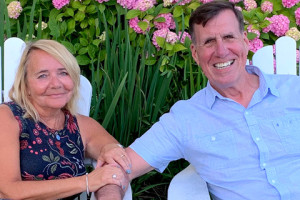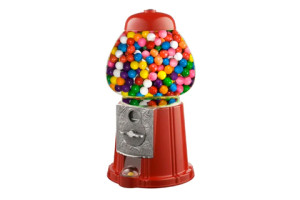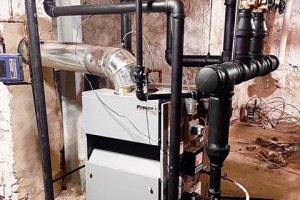
Hello, old friend. I’m writing today to say thanks, and to say farewell. This will be my last column.

There is a restaurant on the ground floor of a large residential building on Manhattan’s Upper West Side that I’ve been servicing for about 15 years now.
It’s a busy place with a small kitchen and they've been there for many years. Located near the Metropolitan Opera House, they’re known in part as a pre-theatre destination so they've got very predictable rush times.
When I first started servicing the restaurant, they were making hot water with a gas-fired 80-gallon, 75,000 Btu, A.O. Smith commercial unit, which we would go on to change twice as management had this place on a three-year cycle, replacing water heaters to avoid doing it on an emergency basis.
Three years ago, we started having some venting problems, as restaurants often do, and so I got the idea on the next replacement to install a direct-vent water heater and decouple the atmospheric pressure fluctuations that were happening within the building’s envelope because of the water heater’s exhaust system.
A.O. Smith’s Cyclone water heater took combustion (intake) air directly from outside via a sealed pipe connected to the burner, and exhausted the unit via another sealed pipe through the side wall next to which the water heater was situated.
Pricey, but the BTH-120 Cyclone unit worked great and it made everyone happy. It was a 60-gallon tank and burned 120,000 Btu that replaced the previous 80/75 unit nicely.
Best of all, the venting problems associated with the old style natural draft water heater were now gone.
Fast forward to December 2014. Just three months ago. On that same three-year schedule, we were contracted to replace the water heater again. The one in place, now three years old, had a sensor that needed to be replaced and management took it as a sign to replace the water heater since commercial water heaters are typically warranted for three years.
This one was a no-brainer. All agreed the replacement unit would be the updated version of the A.O. Smith Cyclone BTH-120. So we scheduled for the kitchen to switch over to an alternate source of hot water they happen to have. Fortunately, we have access to the building’s domestic hot water, but it is metered and expensive and the building doesn’t let it go on for long anyway. We are all lucky that option exists.
The new A.O. Smith Cyclone water heater was a routine, like-for-like replacement, with some minor flue/air intake positioning changes - a routine job for our Journeyman plumbers.
Within just a couple days, the restaurant called to say there was no hot water.
The unit was in a hard lockout and needed to be reset, but the error didn’t make much sense. It cited the kind of condition that, if true, the unit would have never run, so we put the unit back into service, but a few days later, the fault returned and there was no hot water. A few days after that, another fault put the unit into lockout. In my more than 30 years of servicing heating equipment this was an infrequent, yet unfortunately familiar, problem. This water heater had a bad circuit board.
A.O. Smith then directed me to call one of their service companies, who suggested it may not be the circuit board, rather a sensor that they happened to have on their shelf.
The company showed up promptly the next day and replaced the sensor.
This didn’t work for long and the errors returned in short order. The service company then returned with a circuit board and replaced it.
Things worked well for several weeks. At some point they charged us $375, but whatever; I needed this to be behind me.
Still, the restaurant would occasionally complain that the unit would inexplicably run out of hot water at odd times. Some days, first thing in the morning when they opened up, there would be no hot water. They’d go to check it out and see the unit running but the temperature would be low for a long period of time. They’d switch over to the building’s metered hot water, wait for their Cyclone to heat up, then switch back for as long as the hot water kept up. Sometimes that meant all weekend, sometimes a week or more, but never for long.
Meanwhile, the restaurant’s manager called to say there was now a steady drip of water from the unit that they were catching in buckets.
I was actually relieved. This brand new water heater had a lot of problems and was clearly defective. The fact it was leaking meant it would be replaced under warranty. We could start fresh with a new unit.
We called the service company back. They said the leak was condensation dripping off the pipes, and since this was not going to be a warranty issue, they were charging our credit card $375 again (to schedule the service visit, you’re required to leave a credit card and pre-authorize a $375 charge). My brother took the call. When he was told this, he said something like “No way. That can’t be the problem. My tech saw the leak and it’s definitely not the piping. It’s clearly coming from inside the heater’s outer jacket. All the piping is visible and that CANNOT be the problem.”
The owner of the service company then replied to my brother, “Fine. I won’t charge your card. Keep your money, and don’t ever call me again.” He also told me to do something with my body that is physically impossible.
So that happened.
I returned and found the steady leak was the water heater’s insulation absorbing and slowly releasing condensation building up when the tank would go cold periodically.
We then raised the temperature from 145° to 175° and installed a mixing valve to temper the water and lessen the draw while trying to keep the tank hot and free of condensation.
That stopped the drip. Kind of.
Mind you, we kept the old water heater at 145°-150° for three years without incident.
Suddenly one day, the unit stopped working entirely. Blower “prover” errors locked the unit out for good.
Surely, this was a warranty issue, so I called the second service company. They were professional and they came the next day to replace the prover switch.
So now the circuit board, the temperature sensor, and the prover switch were all replaced. This water heater is less than 3 months old.
My customer is losing faith in me and my company after all these years. It’s four degrees outside some days in one of the busiest heating seasons we’ve seen in years. Nobody, but nobody, is happy.
The rep is not even pretending to help. Instead, they keep giving me A.O. Smith’s phone number.
A.O. Smith keeps giving me phone numbers of other plumbers to call.
I feel like I’m losing my mind.
Finally, I turn to my supplier for this unit, West Side Supply in New Jersey, who is appalled at what’s going on and gets on his contact at the area representative’s office to help bring this to resolution.
The first person they had me talk to at A.O. Smith said there was no record of the temperature sensor being shipped or changed in this unit and they insisted I take delivery of a new sensor, install it, and that will take care of the problems.
He “overnighted” me the sensor. It took three days to arrive.
I replaced it in the afternoon. That night, I got the call: No hot water and the restaurant switched again to “building hot water” which they pay for. Again, my salesman called the rep and was insistent something be done to bring this to resolution.
The following morning, the factory called me, this time it was a knowledgeable woman, the Team Lead of Commercial Tech Support.
She’s got a pleasant southern accent and is making a real effort to get to the bottom of what’s wrong here. She’s clearly focused on my installation. She asks for pictures that I send immediately. Nothing wrong there.
The next day she requests a fixture count and the model name and number of the dishwasher.
Here’s where I finally stop being complacent. I explain that I don’t need A.O. Smith to do my engineering and we’re done with trying to divert blame away from this water heater. It is not working like the old one did. It is the same model, same Btu, same recovery ratings, but it’s not working and their own factory service agents can’t keep it running.
Now on everyone’s radar, I brought this update back to my salesman, who called his contact at the rep’s office again. They contacted me immediately and met me the next day, March 13th, at the restaurant. He took all the info about usage, the most significant of which is a low-temp 2.2 gallon-per-cycle dishwasher. This one runs at 130° while most commercial dishwashers require 180° water.
The rep took all this information and spoke to the chef and manager, taking their account of how the water heater seems to behave. They explained that there was simply no pattern to when they would and would not have hot water, and how the old unit was simply not something they ever had to think about. They admitted this new unit had been in service through several periods of extreme use and performed well. Other times, a light-breakfast crowd would set the water heater back to 85° water where it would hover until the dining room emptied.
Finally, I got someone to care and he took the time to come and see what was going on. The installation was fine. The application was typical. Yet, the water heater had big problems from Day One.
He was going to speak to all concerned parties and get back to me “with some options by the end of the day.”
Get ready. Here it comes.
About four hours later, I got a call from Tennessee on my cell phone. I recognized the number. This wasn’t a good sign.
The Tech Support woman greeted me, said that she received the information from the rep and continued simply with, “The unit is undersized. Would you like to discuss options for purchasing a higher output unit that wil give your client more hot water?”
Got that? Four words. “The unit is undersized” and A.O. Smith walks away. They’re done.
No accountability at all. No compromise. No talking about anything except selling me a new, larger water heater. No recommendations like maybe I can install flow restrictors on my faucets or piping. No solid numbers about recovery. I’m waiting for some tech-talk between two professionals that never happens.
A.O. Smith is walking away.
I explained that I understood her position as an employee of A.O. Smith but that she simply didn’t know what she was talking about.
She was sitting with a list of fixtures and some sizing charts and those charts were very liberal, very vague, did not reflect the conditions here and we were not up against doomsday hot-water conditions, where every fixture is running at the same time, the scenario for which those charts lead you to size and purchase a water heater.
A.O. Smith was done speaking to me unless I wanted help in selecting a new model water heater.
I thanked her for her time, I really did, and I called the rep back.
Towing the company line, it was explained to me that it’s a bad situation and that at peak demand the numbers suggest I “should be fine 90% of the time, but it’s that 10% that causes the trouble”.
None of this is the problem. This particular A.O. Smith Cyclone water heater is the problem.
My back is against the wall here. I’m being forced to remove this water heater and replace it with another product by the end of the week at the latest, and at my cost.
This whole episode is costing me something near $10,000 out of pocket and it’s got to stop here.
I also told this story on The Wall and you can read the thoughts of other professionals there. I'd appreciate hearing yours.

Hello, old friend. I’m writing today to say thanks, and to say farewell. This will be my last column.

My six-year-old grandboy, Brendan, was in the vestibule of the diner when the bubblegum machine caught his attention. It was one of those spiral models that appeared in t...

Subdural posed a question on The Wall at HeatingHelp.com in the Strictly Steam section, where some of the sharpest knives in the drawer post every day. The question was a...